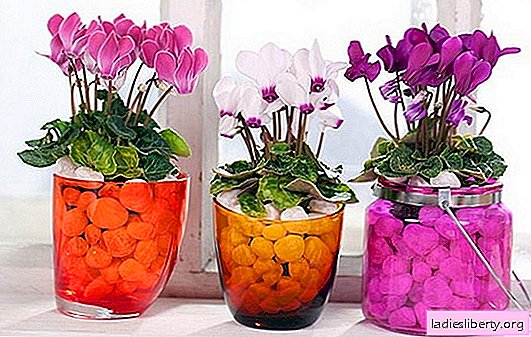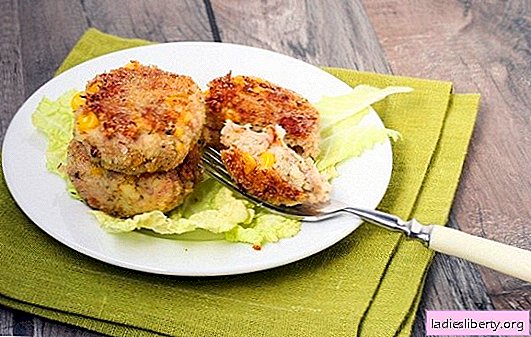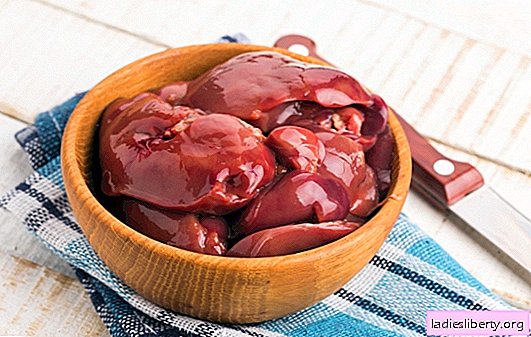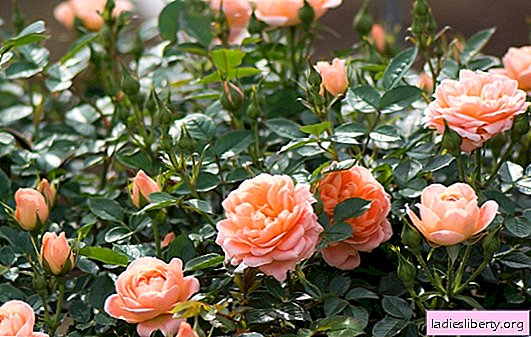
Cyclamen or sloppy - perennial ornamental plant.
The countries of the Mediterranean and Asia Minor are considered his homeland.
The genus Cyclamen (Cyclamen L.) includes about 15 species.
Of these, cyclamen Persian, European, Kos, Neapolitan is most often found on sale.
• Persian cyclamen originally from the Eastern Mediterranean. Has dark green heart-shaped leaves with a marble pattern. It blooms from September to March with double or simple flowers. The color of the flowers varies from white to various shades of red. The rest period is May-June.
• European cyclamen found in the wild in Central and Southern Europe. It is also called alpine violet. Its leaves are smaller than that of the Persian. The flowers exude a fragrance, the intensity of which depends on the color of the flower: the lighter the shade, the finer the smell. This species is the only one of all cyclamens that does not fall during the hibernation period.
• Cyclamen Kos named after the island of Kos, on which it was first discovered. It has its own peculiarity: the petals expand sharply from the base and have a dark spot.
• Cyclamen ivy or Neapolitan differs from other species in the form of leaves: due to the notched-serrated edges, they are similar to ivy leaves. It blooms in September and November. Flowers appear before leaves.
In indoor floriculture, Persian cyclamen is mainly grown. He has developed many varieties. According to the height of the peduncles, they are divided into standard (20-30 cm), medium-sized (15-22 cm) and low-growing (up to 15 cm). The most popular varieties: Charlie, Scarlet Moth, Spring Moth, Lilu, Rose, Flamingo, Sylphide, Topaz, Rembrandt, Elf, Bellissima.
Cyclamens are highly dependent on temperature conditions: they begin to vegetate actively when it is wet and cool. With increasing air temperature, they prepare for a period of rest. This creates a certain difficulty in caring for cyclamen at home, especially in the heating season. However, if you follow certain rules for caring for this whim, then you can admire bright butterfly flowers for more than one year.
Cyclamen: home care - reproduction, transplantation, dormancy
Breeding
At home, propagating cyclamen is not very simple. It can be grown from seeds and tuber divide.
If the seeds are purchased in garden stores, then when buying, you need to look at the expiration dates on the packaging: the seeds retain their germination capacity up to 2 years.
If there is a flowering cyclamen in the house, the grower will have to work with a "pollinator bee" to get his seeds: transfer pollen from one flower with a cotton swab or brush to another. To reinforce success in pollination, the procedure is repeated several times. The best time for this is the morning hours of a sunny day.
Ripened seeds are stored for 2 months and then sown, after soaking them in Zircon.
Peat is mixed with vermiculite or leaf soil in equal parts as a substrate. Seeds do not need to be deeply buried in the soil: having spread them on the surface, they sprinkle with a thin layer of soil. The optimum temperature for germination will be + 20ºС (at a higher value, the seeds will hibernate, and at less than + 18ºС, they are more likely to rot). Landings must be periodically moistened and ventilated.
Shoots begin to appear after about 4-6 weeks. From this moment on, a bowl with seedlings is placed in a well-lit place (but without direct sun) with a temperature of + 15 + 17 ° C. When the seedlings appear small nodules and 2-3 leaves, they are dived into separate containers. A week after this, the plants are fed with mineral fertilizers (the dose is reduced by 2 times from that indicated on the package). Cyclamens grown from seeds bloom 12-18 months after planting. It happens that flowering begins even later (after 3-4 years).
Cyclamen propagation tuber division spend like this:
• During the dormant period of the plant (spring-summer), the tuber is dug from the ground, cut into pieces;
• Each such piece must have a kidney and roots;
• Slices are dried, treated with fungicide or crushed coal;
• Delenki are planted in separate pots and put in a greenhouse or covered with a plastic cup.
When choosing planting material in garden stores, pay attention to the appearance: the tuber should be elastic, not wrinkled, without spots of rot.
Transfer
Cyclamens, especially flowering ones, react poorly to transplants. Therefore, a purchased potted plant or its own can be transplanted when it fades. It is better to postpone this procedure to the beginning of active vegetation (August - early September) - the growth of new leaves after a dormant period will be a sign. A new pot is picked up a little more than the old. At the bottom, a layer of drainage from different-sized fractions of expanded clay or crushed stone is required. It is advisable to shed the soil before planting with a solution of potassium permanganate or fungicide. The depth of the cyclamen tuber during planting depends on the type of plant. So, in Persian cyclamen, tubers are planted in the soil only 2/3, and in other species they are completely buried. The transplanted plant is placed in a non-hot and bright place. Watering as new leaves grow gradually increase.
Rest period
In late spring - early summer after flowering, cyclamen begins a dormant period. Withered leaves and flowers are torn off, watering is reduced to a minimum (so that there is no complete drying of the soil). The pot with the tuber is rearranged or put on its side in a cool, ventilated place and stored this way until autumn. To remove plants from hibernation (early autumn), they bring it to light and gradually increase watering.
Cyclamen home care - soil, lighting, flowering conditions
Lighting
Cyclamens like diffused light, it is better to keep them in partial shade - direct sunlight causes burns on them. The best direction would be west and east. There is not enough light on the cyclamen on the northern windows, and shading is needed on the southern windowsill.
The soil
For well-being, cyclamens need drained and nutritious soil with a slightly acidic or neutral reaction (pH 5.5-6.0). The substrate is made from a mixture of sheet, sod land, sand, humus in equal parts. To determine the acidity of the soil, you can use special test strips. The procedure is carried out as follows: a pinch of soil is mixed with water, the sediment is sedimented and a test strip is lowered into the resulting solution. The result is checked against the scale on the package.

Procedure for determining soil acidity
If there are no such test strips, then you can roughly determine the acidity by the reaction with vinegar - they watered a handful of earth and evaluate the result. If there are many bubbles, then the soil is alkaline, if there are few of them, the reaction is neutral. If nothing happens, the soil is acidic.
Flowering conditions
To cyclamen pleased with its flowering, certain conditions must be met:
• Suitable pot size - in a cramped or too spacious tank, flowering is inhibited;
• Lack of nutrition;
• Unsuitable soil acidity;
• Incorrect planting: Persian cyclamen is planted, leaving the "crown" of the tuber above the ground, the remaining species need root deepening. The distance between the tuber and the edge of the pot is kept at two to three centimeters;
• The plant needs a dormant period and the correct way out of it.
Cyclamen home care - top dressing and watering
Watering
The main rule when watering cyclamen is moderation and accuracy. It is important to prevent waterlogging and overdrying of the earth. This flower is often affected by root rot, so only the bottom layer of soil needs to be moistened. It is better to pour cyclamen along the edge of the pot (so as not to get into the center of the outlet, on leaves and buds) or through a tray: put the pot with the plant in a basin or bucket of water, remove after 15 minutes. During the flowering period, the squash is watered with abundantly defended water. After the plant fades, watering is gradually reduced, and by the beginning of the dormant period (from March to August) they completely stop.
Air humidity
Cyclamen loves when it's wet and cool. Do not keep it near heat sources - the plant will throw off the leaves and go into hibernation. To increase the humidity around the plant, the pot can be placed in a tray with wet pebbles. Before buds appear cyclamen can occasionally be sprayed.
Fertilizer
Cyclamen begins to be fed during the period of active growth and flowering. With the beginning of active growth, for the growth of leaves, they are fed with a complex mineral fertilizer every 2 weeks. When buds appeared, reduce the dose of nitrogen and increase the amount of potassium and phosphorus.
Cyclamen at home: why does he die?
Cyclamen is a demanding plant that is responsive to errors in care. Yellowing of the leaves is possible for several reasons:
• Lack of moisture in the soil and in the air;
• The plant is starving - during the flowering period it must be fed;
• Defeat by pests or diseases;
• Close pot;
• The natural state of the beginning of the dormant period.
If the leaves acquire an ugly shape, stop growing and become stiff, the flowers wither, the flower stalks are bent, which means that a cyclamen mite has come to visit. Conventional insecticides, approved for use at home, do not act on it. The plant will have to be destroyed to prevent the spread of the pest.
Damaged thrips leaves are covered with silver spots. These insects are carriers of the leaf bronze virus, which are deformed, brown “stains” appear on them. Over time, leaf blades are necrotic. A diseased plant cannot be treated; it must be destroyed. Insecticides are used against thrips (Fitoverm, Aktara, Agrovertin).

Thrips Damaged Cyclamen Leaf
If a peduncles grow shorter than leaves and the flowers bloom beneath them, the cause is an improper irrigation regime: waterlogging or overdrying of an earthen coma in combination with a low temperature.
Often cyclamens die from fungal and bacterial diseases. Humid and cold air, coupled with its poor circulation, contribute to the appearance of gray rot. In this case, the leaves turn yellow, gray mold appears on them. Affected parts of the plant must be carefully removed (mold spores spread easily with air movement) and treat the plant with a fungicide (Skor, Fitosporin-M, Fundazol). For prevention, ventilate the room more often, reduce the amount of watering.
Wet rot manifested by a sharp withering of the plant and putrid odor of the root system. Infection occurs through infected water or a diseased plant. Can not be treated.
Fusarium - a fungal disease that affects the vascular system of the plant. Manifested in yellowing leaves, often on one side of the plant. Over time, the fungus affects the entire plant. In the initial stage of the disease, cyclamen is watered with a solution of foundationazole, the ground part is sprayed with Topsin-M.

Fusarium wilting cyclamen











